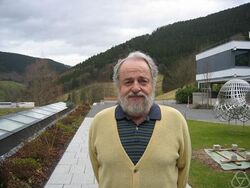Biography:John Friedlander
John Benjamin Friedlander | |
|---|---|
 Friedlander in 2008 | |
| Citizenship | Canadian |
| Alma mater | University of Toronto, University of Waterloo, Pennsylvania State University |
| Known for | Analytic number theory Bombieri–Friedlander–Iwaniec theorem |
| Awards | Fellow of the Royal Society of Canada, Jeffery–Williams Prize, Fellow of American Mathematical Society, 2012 |
| Scientific career | |
| Fields | Mathematics |
| Institutions | Institute for Advanced Study MIT University of Toronto |
| Doctoral advisor | Sarvadaman Chowla |
| Doctoral students | Cem Yıldırım |
John Friedlander FRSC is a Canadian mathematician specializing in analytic number theory. He received his B.Sc. from the University of Toronto in 1965, an M.A. from the University of Waterloo in 1966, and a Ph.D. from Pennsylvania State University in 1972. He was a lecturer at M.I.T. in 1974–76, and has been on the faculty of the University of Toronto since 1977, where he served as Chair during 1987–91. He has also spent several years at the Institute for Advanced Study. In addition to his individual work, he has been notable for his collaborations with other well-known number theorists, including Enrico Bombieri, William Duke, Andrew Granville, and especially Henryk Iwaniec.[1]
In 1997, in joint work with Henryk Iwaniec, Friedlander proved that infinitely many prime numbers can be obtained as the sum of a square and fourth power: a2 + b4.[2][3] Friedlander and Iwaniec improved Enrico Bombieri's "asymptotic sieve" technique to construct their proof.[4]
Awards and honors
- In 1999, Friedlander received the Jeffery–Williams Prize.
- In 1988, Friedlander became a fellow of the Royal Society of Canada.[5]
- In 2002, CRM-Fields-PIMS prize
- In 2012, he became a fellow of the American Mathematical Society.[6]
- In 2017, he received the Joseph L. Doob prize, jointly with Henryk Iwaniec, for their book Opera de Cribro.[7]
Selected publications
- Friedlander, John; Iwaniec, Henryk (2010). Opera de Cribro. Providence: American Mathematical Society. ISBN 978-0-8218-4970-5. https://books.google.com/books?id=GJSKAwAAQBAJ.[8][9]
See also
- List of University of Waterloo people
References
- ↑ "John B. Friedlander (Toronto)". Centre de recherches mathématiques. http://crm.math.ca/prix/prixCRMFieldsPIMS/prix_CFPFriedlander_an.shtml.
- ↑ Friedlander, John; Iwaniec, Henryk (1998). "The polynomial X2 + Y4 captures its primes". Annals of Mathematics 148 (3): 945–1040. doi:10.2307/121034. http://www.emis.de/journals/Annals/148_3/fried1.pdf.
- ↑ Friedlander, John; Iwaniec, Henryk (1997). "Using a parity-sensitive sieve to count prime values of a polynomial". PNAS 94 (4): 1054–1058. doi:10.1073/pnas.94.4.1054. PMID 11038598. Bibcode: 1997PNAS...94.1054F..
- ↑ International Team Shows that Primes Can Be Found in Surprising Places
- ↑ Search Royal Society of Canada Fellows , retrieved 2013-01-2013.
- ↑ "Fellows of the American Mathematical Society". November 26, 2018. https://www.ams.org/cgi-bin/fellows/fellows.cgi.
- ↑ "Joseph L. Doob Prize". November 26, 2018. http://www.ams.org/prizes-awards/paview.cgi?parent_id=21.
- ↑ Thorne, Frank (2012). "Book Review: An introduction to sieve methods and their applications by Alina Carmen Cojocaru and M. Ram Murty and Opera de cribro by John Friedlander and Henryk Iwaniec". Bulletin of the American Mathematical Society 50 (2): 359–366. doi:10.1090/S0273-0979-2012-01390-3. ISSN 0273-0979.
- ↑ Stenger, Allen (August 16, 2010). "Review of Opera de Cribro by John Friedlander and Henry Iwaniec". https://www.maa.org/press/maa-reviews/opera-de-cribro.
External links
- John Friedlander at the Mathematics Genealogy Project
- John Friedlander's profile in Toronto's Focus on Research.
- On Bombieri's asymptotic sieve
 |

